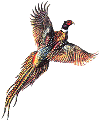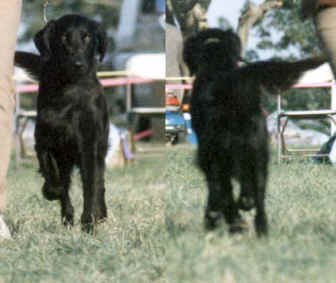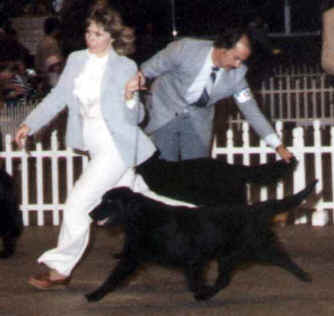|
The Flat Coat Standard and Movement by Roger Orton Recently, I was asked a question about the relative importance of Flat Coat gait, viewed coming and going. It was pointed out that the last revision of our Standard eliminated the previous direct reference to gait when viewed from the front or rear. This person noted that the judge at our National Specialty, when discussing the entry at our banquet, commented that he didn’t view some dogs coming and going because of the emphasis on side movement in our Standard. The question as to why this discussion of movement was eliminated from our current Standard is a good one, and deserves comment.
I don’t know why our Standard Committee left this discussion of movement out of our current Standard, but I believe at this point, that they probably feel it was a mistake. I do know that the AKC wants to see standards written in a very specific format. Also, the Flat Coat Standard is one of the longer standards and possibly this was left out as a matter of priority, yielding to AKC wishes to keep the Standard as short as possible. The Committee may have felt the discussion of temperament and character was a priority, thinking that all judges would know how to judge up and back movement. In any case I believe the Committee feels the Flat Coat should have sound efficient movement, when viewed at ANY angle. If you read many standards, as I do, you will soon find that they all tend to sound the same in many ways. Not the Flat-Coated Retriever Standard. It assumes that most people know what is the same in dogs, and it dwells on what makes a Flat Coat different. Most of the verbiage is devoted to what makes a Flat Coat distinct from other breeds, not how they are similar. It is by far one of the best, if not the best standard in the whole lot. So, what about the Flat Coat Standard and Movement?
Skipping over the unique head for the sake of this discussion, the General appearance section of the Standard goes on to describe the silhouette. "...the head is set well into a moderately long neck which flows smoothly into well laid back shoulders. A level topline combined with a deep, long rib cage tapering to a moderate tuck-up create the impression of a blunted triangle. The brisket is well developed and the forechest forms a prominent prow. This utilitarian retriever is well balanced, strong, but elegant: never cobby, short legged or rangy." Now, re-read that section five times, then stop and think about it. Get a picture? Let me add a couple other points from later in the Standard. The Flat Coat is longer than tall. His chest is only moderately broad. His front is well angulated and his rear is in balance, but not overangulated. His croup slopes slightly and the tail is a smooth extension of the topline. Get a better picture? A long neck; long, deep rib cage; prominent prow; level back; good angulation; never cobby; this is a Flat Coat. He is a utilitarian hunting retriever; strong but elegant. That bears repeating, strong but elegant. I hope that gives you a good idea of the silhouette. It’s important because the silhouette is what makes this breed most suited to what he was bred for. The Flat-Coated Retriever is a utilitarian hunting retriever. As such, the Flat Coat may spend all day in the field. He does not necessarily sit in a blind or a boat all day. His natural gait is mostly a trot or walk, not the full gallop of a field trial Labrador. Since this is the Flat Coat’s role, the bulky mass of a Golden or Labrador is a hindrance. He needs enough mass to keep from freezing while spending the day in and out of cold water, but he must have the strength to go all day in the field. Strong but elegant. Finally, we get to movement. Why is movement so important? It’s important because the Flat Coat has to work; and work all day long. He is relatively long in body and well angulated so he can reach and drive efficiently in a trot. The longer his stride, the less energy is required to get from here to there. He is not short legged because this would reduce the length of stride. He is not cobby because, in a well angulated dog, his rear would interfere with his front legs while trotting, causing him to crab and over-reach, or compensate in some other manner. He is not rangy because he would not have the strength to endure a full days work. In fact, in conformation, the Flat Coat should not have any structural imperfection which would inhibit efficient, free flowing, well coordinated and effortless movement. This would include an over or under angulated front or rear, steep croup, short rib cage, long weak loin, shallow chest, too much mass, weak pasterns, poor feet, or even poor movement coming and going. So, we finally touch on the real question. Yes, movement coming and going is important. The Standard says, "Sound, efficient movement is of critical importance to a hunting retriever." The strength and endurance of the Flat-Coated Retriever depends on strong, straight columns of support on all four corners. It is probably less important than what has previously been discussed, but it is still very important. Serious problems in movements such as toeing in, weak pasterns, flat feet or severe cow hocks create a weakness in a dog’s support column which should remain straight and strong. These imperfections cause undo strain on bones and joints and lead to arthritic conditions or other degenerative joint conditions which will eventually impact the dog’s ability to work. Also, it takes more energy to push a column which is bent and crooked than a straight column. This is not the major factor, but it is still a factor. There are other movement faults that are mainly seen coming and going, such as moving too close or too wide, or throwing elbows. These faults, in my opinion are less important by themselves, but they are often indicative of other structural problems that are apparent when viewed from the side. So, there it is. My opinion. The most important factors which make up the Flat Coat are described in the General Appearance section of the Standard. There are, however, other factors which are common to nearly all breeds of dogs which are also important. Since, this is a sporting breed and is meant to be a hunting retriever, these unmentioned factors are even more important than in other breeds who are not meant to work all day. Remember, strong but elegant.
Updated 09/27/98 |

 I will comment at length about type in the Flat Coat, but first I
think it’s important to evaluate the judge’s comment. He did not evaluate
movement coming and going because the Flat-Coated Retriever Standard emphasizes side gait.
It is true that the Standard emphasizes side gait, however, I don’t believe that
sound efficient movement coming and going was meant to be disregarded. I believe, if an
AKC rep. had been standing ringside during this judging, the judge would have received a
negative observation report. In an effort to taylor his judging procedure to the Standard,
I believe this judge made an error.
I will comment at length about type in the Flat Coat, but first I
think it’s important to evaluate the judge’s comment. He did not evaluate
movement coming and going because the Flat-Coated Retriever Standard emphasizes side gait.
It is true that the Standard emphasizes side gait, however, I don’t believe that
sound efficient movement coming and going was meant to be disregarded. I believe, if an
AKC rep. had been standing ringside during this judging, the judge would have received a
negative observation report. In an effort to taylor his judging procedure to the Standard,
I believe this judge made an error. To understand the priorities of importance in the Flat Coat one
must look no further than the first paragraph of the Standard, General Appearance. It
states there, "The distinctive and most important features of the Flat-Coat are the
silhouette (both moving and standing), smooth effortless movement, head type, coat and
character." Notice movement is mentioned twice, and both times seemingly from the
side. That’s because it is important. Another matter of import is the fact that
movement is tied to the silhouette. Without the proper silhouette, the Flat Coat could not
move the way he is supposed to move. This is of great importance.
To understand the priorities of importance in the Flat Coat one
must look no further than the first paragraph of the Standard, General Appearance. It
states there, "The distinctive and most important features of the Flat-Coat are the
silhouette (both moving and standing), smooth effortless movement, head type, coat and
character." Notice movement is mentioned twice, and both times seemingly from the
side. That’s because it is important. Another matter of import is the fact that
movement is tied to the silhouette. Without the proper silhouette, the Flat Coat could not
move the way he is supposed to move. This is of great importance.